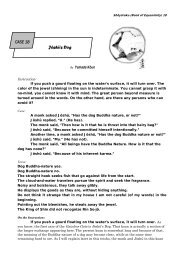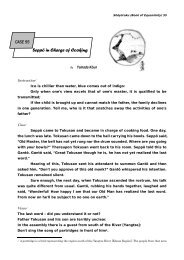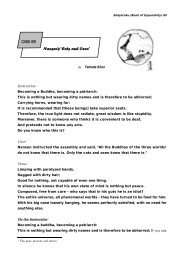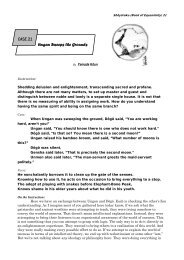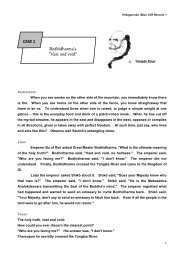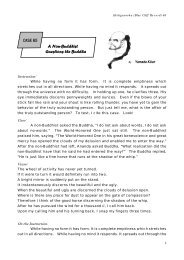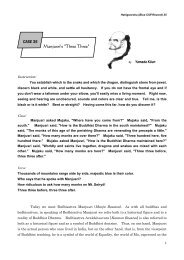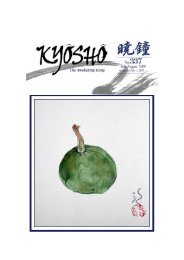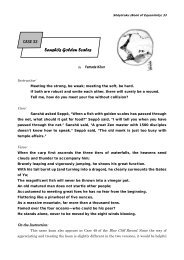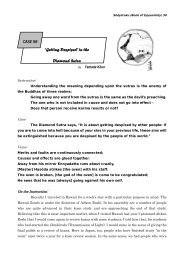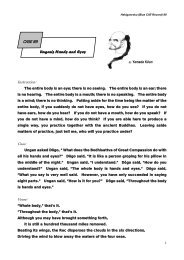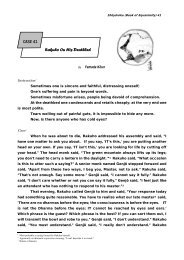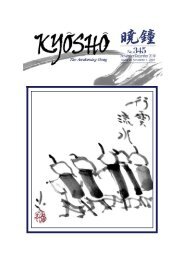CASE 90
CASE 90
CASE 90
You also want an ePaper? Increase the reach of your titles
YUMPU automatically turns print PDFs into web optimized ePapers that Google loves.
Hekiganroku (Blue Cliff Record) <strong>90</strong><br />
<strong>CASE</strong> <strong>90</strong><br />
Chimon’s<br />
Prajna Wisdom<br />
By Yamada Kôun<br />
Instruction:<br />
The thousand sages cannot transmit the word before any sound. The<br />
single thread before your eyes continues on for eternity without ending. It is<br />
completely naked and revealed. The hair grows in natural profusion and the<br />
ears are sticking up. Just tell me. What is this about? To test I am citing<br />
this. Look!<br />
Case:<br />
A monk asked Chimon, "What is the body of wisdom?" Chimon said, "An<br />
oyster swallows the moonlight." The monk said, "What is the activity of wisdom?"<br />
Chimon said, "A rabbit becomes pregnant."<br />
Verse:<br />
A single piece of solid emptiness transcends all words and intellection.<br />
As a result of this, both humans and heavenly beings see Subhuti.<br />
The profound meaning of the oyster swallowing the wondrous rabbit.<br />
This was given to Zen students in the past and caused a great struggle.<br />
On the Instruction:<br />
Chimon Kôsaku Oshô was grandson in the Dharma to Unmon Daishi and the teacher<br />
of Setchô Zenji, the author of the Blue Cliff Record. Except for some slight differences, this<br />
Instruction is exactly the same as that for Case 94, a fact which has led some scholars to<br />
conclude that it was mistakenly included with this case. Nevertheless, the greater part of this<br />
Instruction is perfectly fitting for today's case and I follow convention by delivering my teisho<br />
beginning with that Instruction.<br />
The thousand sages cannot transmit the word before any sound. Let me<br />
begin by mentioning that the first line of the Instruction had the effect of setting off a deep<br />
experience in the case of our own Kubota Ji’un Roshi. If we speak, says the Instruction, this<br />
will always be preceded by concepts, ideas or images which then become speech. What, then,<br />
is a word before any sound? Speaking in simple terms, it is the essential heart or essential<br />
1
Hekiganroku (Blue Cliff Record) <strong>90</strong><br />
mind which exists prior to any concepts or thoughts. It can also be seen as referring to "your<br />
original face before your parents were born," the text of yet another koan. Moreover, it can be<br />
viewed as the "voice of the crow before he cries." This is also a koan about which there is an<br />
interesting tale concerning Osatsu Bâsan (Old Lady Osatsu), one of the lay students of Hakuin<br />
Zenji.<br />
When Osatsu was still a young woman (it appears that she came to realization at an<br />
early age), her father came once to Hakuin Zenji seeking advice about his daughter who had<br />
been saying all sorts of strange things. In reply, Hakuin Zenji gave the man a waka verse<br />
which starts as follows, telling him to show it to his daughter: "In the darkness of night,<br />
hearing the voice of the crow which has not cried..." Upon being shown the verse, Osatsu<br />
immediately smiled. This "voice of the crow which has not cried" could also be taken as the<br />
"word before any sound."<br />
When I lived in Manchuria, Nakagawa Sôen Roshi once brought me a souvenir of his<br />
trip to Kumgang (Diamond) Mountain in Korea. Along with a pine cone he had picked up on<br />
the mountain was a waka verse he had composed which ran as follows:<br />
Pine seeds from the Diamond Mountain,<br />
when I eat them<br />
they have the fragrance of my mother's milk<br />
before she was born.<br />
This, too, could be seen as "a word before any sound," a sound which cannot be transmitted<br />
under any circumstances. There is nothing to transmit; it is totally empty. It could be known<br />
as "the heart mind before the beginning of time" which can never be transmitted by the<br />
patriarchs and Buddhas. We speak often of transmitting the Dharma. But when it comes to<br />
the heart-mind existing prior to all thought, that is, our essential nature, no matter how many<br />
Buddhas there were, it could never be transmitted. There is nothing to transmit.<br />
The single thread before your eyes continues on for eternity without<br />
ending. "The single thread" could be a reference to any number of things. It could even be<br />
taken as a metaphor for Mu...or "it's hot," "it's cold" or "Kanshiketsu" [a dried shit stick].<br />
These are all examples of the single thread before your eyes. It is every split second. And in<br />
that split second is contained eternity. There is no eternity other than in that split second.<br />
"Ouch!" – that "ouch" contains eternity. Speaking more intellectually, we could say our life<br />
never ends. Where, then, is that life? "Ouch!" That is life, that is Buddha-nature. This<br />
life is eternal and never broken at any point. It is infinite in terms of time and space. And<br />
even while we speak of infinite in time, it is completely empty. It is every single second.<br />
"Ouch!" Being happy, being sad, standing up, sitting down. They all take place in time and<br />
they are all instantaneous, moment-to-moment. And in that moment is eternity. Eternity is<br />
infinite; therefore, it can never end halfway. Truly: “The single thread before your eyes<br />
continues on for eternity without ending.”<br />
It is completely naked and revealed. "Completely naked and revealed" means<br />
2
Hekiganroku (Blue Cliff Record) <strong>90</strong><br />
"just as it is without any thing sticking." It is the state where all concepts and thoughts have<br />
dropped away and the true fact is revealed just as it is. This is our true nature, no longer<br />
wearing the clothes of our own concepts. What does this mean in more concrete terms? When<br />
you stand up, there is just that standing without any thinking. The same goes for sitting<br />
down, eating and everything else. There is nothing sticking to it. This is the human being in<br />
his or her original form. It has been said that human beings are animals who use thoughts for<br />
their food. We are always thinking something the whole day long. But whatever you have in<br />
your head is not reality, it is nothing more than some sort of imagining.<br />
The hair grows in natural profusion and the ears are sticking up. "Hair<br />
growing in natural profusion" is also a reference to our original natural state, our essential<br />
nature. The same is true for the line about ears sticking up. They are all metaphors for<br />
that perfectly natural state where there is nothing sticking.<br />
Just tell me. What is this about? To test I am citing this. Look!<br />
“However, has there ever been anyone like this?" we are asked. An example of this totally<br />
natural state will be given now and we are told to look carefully.<br />
On the Case:<br />
A monk asked Chimon, “What is the body of wisdom?” Chimon said, “An<br />
oyster swallows the moonlight.” The monk said, “What is the activity of<br />
wisdom?” Chimon said, “A rabbit becomes pregnant.” It's probably difficult for you<br />
to understand this without any explanation. The word wisdom has been used here as a<br />
translation of the Sanskrit prajna [jp.: chie]. Needless to say, this is not a reference to<br />
knowledge acquired by study, as in the case of a doctor who learns how to prescribe a certain<br />
medicine for a certain illness. Wisdom in this case means the intrinsic wisdom with which we<br />
are born.<br />
For example, when a newborn baby is hungry she will begin to cry. The baby did not<br />
learn how to do this, and yet she knows to cry when she is hungry. This is the wisdom we are<br />
referring to here.<br />
In ancient China and likewise in the Zen tradition it was customary to divide<br />
phenomena into the three classes of body or substance [Tai], form [Sô] and activity [Yô]. The<br />
substance of this stick, for example, is wood. Its form is black and elongated. Its activity is<br />
shown in the hitting.<br />
Prajna wisdom is also divided in like manner for sake of explanation although it is<br />
essentially indivisible. That is, when we make such a division, we must be constantly aware<br />
that we are talking about the same single reality, and that it is basically impossible to divide<br />
this up.<br />
A monk once came to Chimon and asked, "What is the body of wisdom?" Chimon's<br />
answer was, "An oyster swallows the moonlight." To understand this, you must know a little<br />
about the scientific thinking of the ancient Chinese. Those people of the past believed that<br />
3
Hekiganroku (Blue Cliff Record) <strong>90</strong><br />
during the night of the full moon in autumn, oysters would come to the surface of the water and<br />
open up their shells wide to receive the moonlight, after which a pearl would grow in the oyster<br />
as a result. The people of that time considered this to be the most natural thing in the world.<br />
They considered it to be intrinsic wisdom at work. Thus Chimon, with his answer, was saying<br />
that prajna wisdom was found in having that ability.<br />
The monk then asked, "What is the activity of wisdom?" Chimon's answer this time<br />
was, "A rabbit becomes pregnant." This is also based on a similar Chinese belief that on the<br />
night of the full moon in the mid-autumn festival, the rabbit would open its mouth to receive<br />
the moonlight, after which a baby would be formed in her belly.<br />
When Zen masters of today deliver a teisho on this koan they go to great lengths to<br />
come up with something which will cover the fact that they don't know what to say! Chimon's<br />
answers show the way which the ancients used to express these intrinsic abilities of the oyster<br />
and the rabbit. But how would we moderns reply appropriately to the monk's questions? I<br />
am more interested in what you would say than in any talk about oysters and rabbits. This is<br />
the point in dokusan where I would be "grilling you over the fire," so to speak.<br />
When I worked on this koan with Yasutani Roshi, he spoke of how the ancient Chinese<br />
considered it the most natural thing in the world for the oyster to come to the water's surface<br />
and imbibe the rays of the moon to produce a pearl. However, upon considering the matter<br />
now, I feel this is not enough as a reply to this koan.<br />
To give an example, there is the following exchange recorded between Jôshû Oshô and<br />
a monk named Daiwa:<br />
Jôshû asked Daiwa, "How does wisdom show its body?"<br />
(This is almost the same as the question in today's koan).<br />
Daiwa said, "How does wisdom show its body?"<br />
He answered using the exact same words as the question. As I am always telling you,<br />
everything in the phenomenal world is the essential world itself. The answer, "How does<br />
wisdom show its body?" given in reply to a question with the same words is our essential nature<br />
itself.<br />
Upon hearing this, Jôshû laughed loudly.<br />
He was no doubt very pleased with this answer. That loud laughing, too, is itself the body of<br />
wisdom. Do you understand?<br />
The next day, as Jôshû was sweeping the grounds, Daiwa came to him and asked the<br />
same question, "How does wisdom show its body?" Jôshû threw away his broom and laughed<br />
loudly. This again is itself the body of wisdom.<br />
In his short comment appended to the monk's first question in today's koan, Engo Zenji<br />
says, "Throughout the body there is no shadow, no form." The body of wisdom is emptiness<br />
itself. Our own heart-mind contains nothing at all. This, just as it is, is the body of wisdom.<br />
Phrasing this question in more modern terms, we could say something like, "What is the<br />
essence of life?" Life, too, has myriad capabilities. Try to come up with something as an<br />
4
Hekiganroku (Blue Cliff Record) <strong>90</strong><br />
answer to this if I were to ask you in dokusan.<br />
"What is the body of wisdom?" In reply, I would just sit perfectly still in zazen. There<br />
is no need to say "Mu." "What is the form of wisdom?" I would stand with my hands folded<br />
on my chest. "What is the activity of wisdom?" I would walk in kinhin.<br />
What are some other possibilities? "What is the body of wisdom?" A baby sleeping<br />
peacefully. "What is the form of wisdom?" Waking up, opening up his eyes and smiling.<br />
"What is the activity of wisdom?" Crying loudly.<br />
In reply to my question, "What is the body of life," you could give many answers. For<br />
example, just like the baby, you could show yourself sleeping peacefully. "What is the form of<br />
life?" Waking up and yawning. "What is the activity of life?" "Well, time to go to work."<br />
The essential life is anything in the phenomenal world. It is because there is life that we can<br />
move our hands and arms but there is absolutely no way we can show that life other than to use<br />
those arms and legs.<br />
Recall the waka verse I quoted in yesterday's teisho:<br />
To my great surprise,<br />
the life of the cloudless sky<br />
is mountains, rivers, the great earth.<br />
The life of my life is my hands, feet, head and body. Without them there is no life. Both the<br />
phenomenal world and the essential world are life itself. The life of the phenomenal world is<br />
our essential nature. Our essential nature is the phenomenal world itself. They are<br />
intrinsically one, and if we attempt to make a division it dies. This body of wisdom is seen<br />
from the essential point of view.<br />
On the Verse:<br />
A single piece of solid emptiness transcends all words and intellection.<br />
The original Chinese uses the expression "a single piece" but this is actually talking about the<br />
entire universe. In mathematics, we speak of the square of a number. The "single piece" is<br />
the square of emptiness. It cannot be expressed in words or thought. We are speaking, of<br />
course, about essential nature.<br />
As a result of this, both humans and heavenly beings see Subhuti. It is the<br />
result of grasping this reality that both humans and heavenly beings (in the Buddhist<br />
cosmology) see Subhuti. Subhuti [Kûshô in Japanese] was one of the most important disciples<br />
of Shakyamuni Buddha and considered to have the most profound realization of emptiness. In<br />
other words, when we realize the emptiness of our essential nature we can meet Subhuti for the<br />
first time since we have realized the world of emptiness.<br />
The profound meaning of the oyster swallowing the wondrous rabbit.<br />
"The wondrous rabbit" is a metaphor for the moon, and this line is referring back to Chimon's<br />
answer in the main case. It says that this has a very profound meaning. There have been<br />
many commentaries on this line from the verse. Engo Zenji, for example, in his critical<br />
5
Hekiganroku (Blue Cliff Record) <strong>90</strong><br />
comment appended to this line, has the following to say: "What is his meaning? What need is<br />
there to additionally say, 'profound meaning'?" If you ask me, there is no meaning. In fact, if<br />
there were any meaning it would no longer be profound.<br />
Here the poet uses the expression "profound meaning" to express this fact, but in truth<br />
it is precisely this profound truth which can never be known. For example, when you eat your<br />
food it is digested by the digestive tract. But no one knows where this ability comes from. A<br />
doctor can prescribe medicine to strengthen the digestive function but there isn't a doctor in the<br />
world who can tell you what that function is. It doesn't mean, it just is!<br />
There are countless other examples of this. What is seeing with the eyes? Can you<br />
explain that to me? What is that ability and why do we have it? No one knows. This is<br />
indeed a profound truth, a wondrous truth which transcends any intellection. We can only<br />
marvel at it.<br />
This was given to Zen students in the past and caused a great struggle.<br />
Nevertheless, this koan was given to Zen students by Chimon in the past, with which he sowed<br />
the seeds of dissension in the form of Dharma combat and Zen exchanges.<br />
This is a very interesting koan which is probably somewhat difficult to understand at<br />
the outset. The main point has nothing to do with oysters and rabbits. In considering our<br />
essential nature, our life, our essential heart-mind, we can do nothing but marvel at them. It<br />
is in this sense that you should savor this extremely interesting koan.<br />
6



